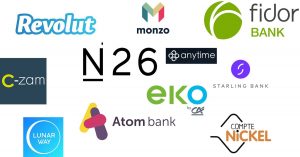Fintechs are pushing the financial services industry to give up “the way we’ve always done it” for something new. The latest hot firms are companies like N26 and Revolut, which fall under the loosely defined umbrella term, “neobanks.”
These digital-only banks provide typical banking services like checking and savings accounts, but also cast a wide net. Offerings also include peer-to-peer money transfers, stock trading, insurance, and money management tools.
Tech-savvy consumers are flocking to neobanks, which offer at-your-fingertips information and services. According to Accenture, digital-only banks added 5 million users in the first half of the year, and growth shows no sign of slowing. In the next 12 months, it’s expected that UK usership will grow from 13 million to 35 million.
Cost is another factor working against traditional brick-and-mortar bank establishments. Average operating cost per consumer is only £20 to £50 for digital-only banks versus £170 for traditional establishments. Those savings are being passed along to consumers, and users are overwhelmingly impressed with the service their receiving. Net Promoter Score for digital-only banks has hit 62, compared to only 19 for traditional banks.
There are some caveats, though. Regulators can be fickle, and after recent innovation failures like MoviePass and WeWork, neobanks should prepare for enhanced scrutiny. Additionally, digital-only banks may not offer the same protections as traditional institutions, including FDIC protections.
Some digital-only firms have worked around this by aligning themselves with established firms. For instance, Chime has partnered with Bancorp Bank to ensure it can protect its users. Brick-and-mortar banks are also experimenting with their own digital-only services. Chase launched Finn to compete in this space, but eventually sunset it and folded its service profile into its other offerings.
Point 72 Ventures sees solutions like Finn becoming more common, with traditional institutions likely to feel pinched by growth in the neobank space. While it’s unlikely that brick-and-mortar banks are going to disappear, they will need to become more responsive to a younger, tech-savvy usership.
“What they tend to lack is the modern technology,” he said. “For a majority of the new features or capabilities that neobanks are talking about, you can almost inevitably point to another technology provider that is enabling incumbents to do something similar.”
The big opportunities seem to be in developing territories where the market isn’t saturated with establishment banks. Latin America, the Philippines, and Indonesia are all ripe targets.
The question facing digital-only fintechs is one of staying power. Will they be able to establish themselves and grow roots, or are they simply a catalyst for long-standing institutions to finally adapt to changing technologies in order to woo the next generation of consumers? While digital-only providers might be nimble, they don’t have the trust and confidence of incumbents. And when it comes to long-term investment, competing with long-standing names in the industry on evaluating credit worthiness and risk is an uphill battle.
























